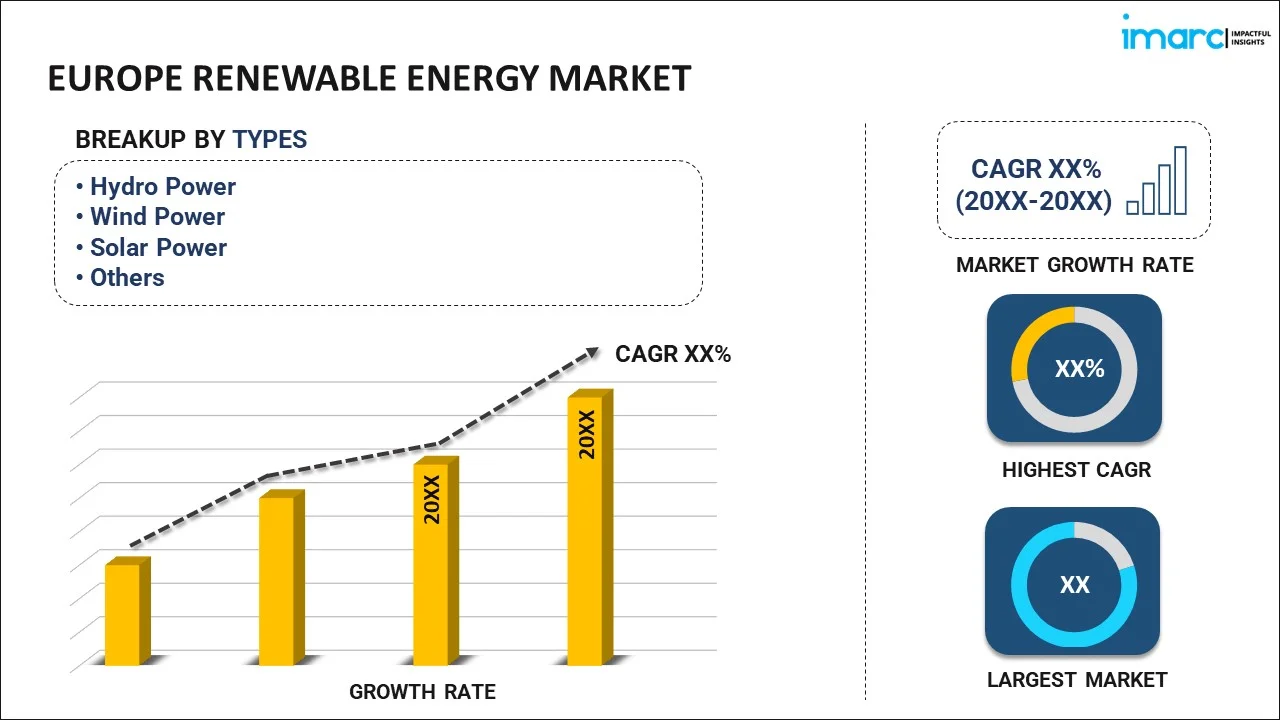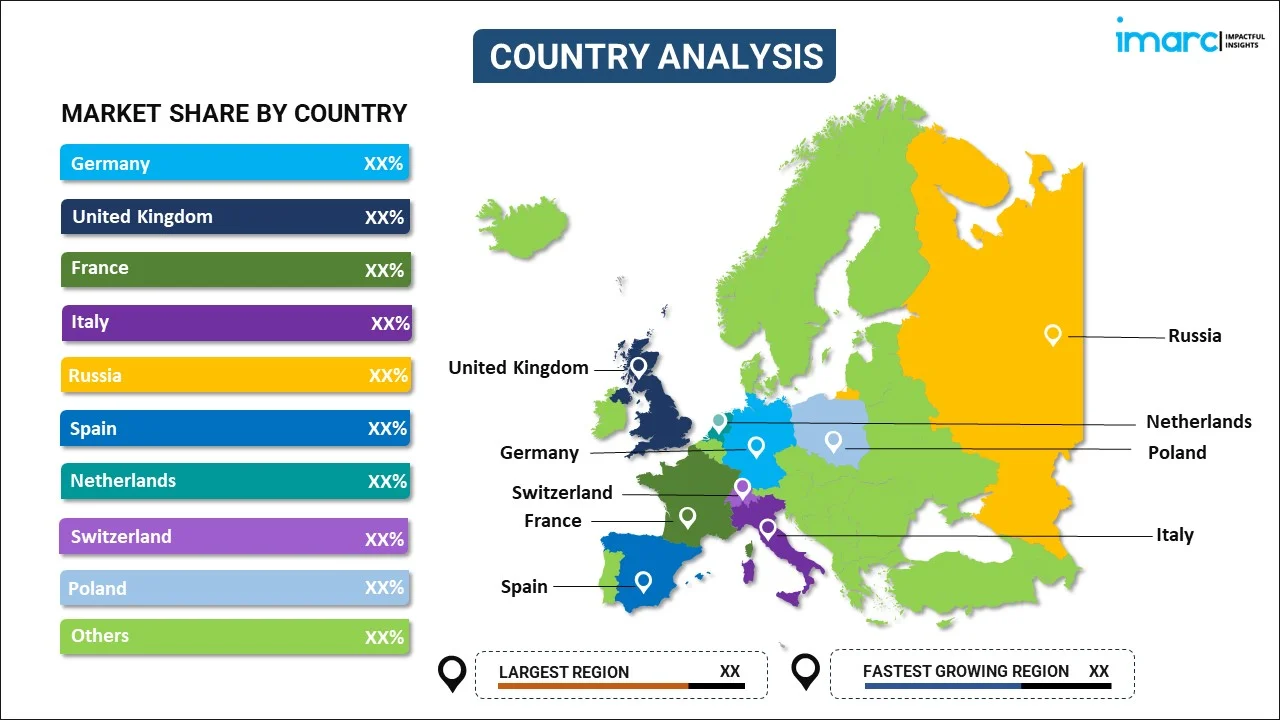
Europe Renewable Energy Market Report by Type (Hydro Power, Wind Power, Solar Power, Bioenergy, and Others), End User (Industrial, Residential, Commercial), and Country 2025-2033
Europe Renewable Energy Market Overview:
Europe renewable energy market size reached USD 241.9 Billion in 2024. Looking forward, IMARC Group expects the market to reach USD 445.0 Billion by 2033, exhibiting a growth rate (CAGR) of 7.01% during 2025-2033. Advances in technology and economies of scale have lowered renewable energy costs, boosting competitiveness against fossil fuels and driving market growth. In 2023, renewables accounted for 24.5% of the EU’s energy consumption, up from 23.0% in 2022. The EU now targets 42.5% of gross final energy consumption from renewables by 2030, with an aspirational goal of reaching 45%, highlighting its commitment to accelerating the energy transition.
|
Report Attribute
|
Key Statistics
|
|---|---|
|
Base Year
|
2024 |
|
Forecast Years
|
2025-2033
|
|
Historical Years
|
2019-2024
|
| Market Size in 2024 | USD 241.9 Billion |
| Market Forecast in 2033 | USD 445.0 Billion |
| Market Growth Rate (2025-2033) | 7.01% |
Renewable energy refers to energy derived from natural resources that are inexhaustible and environmentally sustainable. These sources include sunlight, wind, rain, tides, waves, and geothermal heat. Unlike non-renewable energy sources such as fossil fuels, renewable energy options generate power without depleting finite resources or emitting harmful pollutants, contributing to a cleaner and more sustainable energy future. Solar energy harnesses the sun's rays through photovoltaic cells, wind power captures the kinetic energy of moving air, and hydropower utilizes the force of flowing water. Geothermal energy taps into the Earth's internal heat, while biomass converts organic materials into usable fuel. The adoption of renewable energy technologies plays a crucial role in mitigating climate change, reducing dependence on fossil fuels, and promoting a greener, more resilient energy infrastructure.
Europe Renewable Energy Market Trends:
Expansion of Green Hydrogen Projects
Green hydrogen is emerging as a cornerstone of the European renewable energy infrastructure market, driven by its potential to decarbonize sectors where direct electrification is difficult. Countries such as Germany, Spain, and the Netherlands are investing heavily in electrolysis facilities powered by wind and solar. Large-scale pilot projects and cross-border hydrogen corridors are being planned to connect production hubs with industrial demand centers. This momentum is supported by funding under the EU Hydrogen Strategy, which aims to scale up capacity rapidly by 2030. As costs of electrolysis technology fall and renewable generation grows, green hydrogen is set to play a major role in cutting emissions in steelmaking, transport, and chemical production.
Strong Policy Commitments and Climate Goals
European governments continue to push ambitious renewable energy targets as part of their broader climate objectives. The renewable energy market Europe is being shaped by the European Green Deal, “Fit for 55” package, and national energy strategies, all designed to accelerate the shift away from fossil fuels. Binding targets for renewable energy share, stricter emission reduction milestones, and supportive financial instruments such as subsidies and carbon pricing have created a favorable investment climate. This policy backing has not only encouraged the expansion of solar, wind, and bioenergy but has also prompted utilities and private companies to commit to long-term procurement. These clear policy signals strengthen investor confidence and drive faster deployment across the European renewable energy market.
Falling Costs of Renewable Technologies
The declining cost of renewable energy technologies continues to reshape green energy Europe, making clean power increasingly competitive with fossil fuels. Onshore and offshore wind, utility-scale solar, and energy storage solutions are now often cheaper than conventional generation. Advancements in turbine design, larger-scale solar modules, and improved supply chains have driven significant efficiency gains and lower capital costs. As a result, new projects in the clean energy Europe sector are achieving record-low auction prices, making them the preferred option for utilities and investors. This cost advantage, combined with rising carbon costs for fossil-based generation, is accelerating the retirement of coal and gas plants, reinforcing the EU renewable energy market as the backbone of future electricity generation.
Europe Renewable Energy Market Segmentation:
IMARC Group provides an analysis of the key trends in each segment of the market, along with forecasts at the regional and country levels for 2025-2033. Our report has categorized the market based on type and end user.
Type Insights:

To get more information on this market, Request Sample
- Hydro Power
- Wind Power
- Solar Power
- Bioenergy
- Others
The report has provided a detailed breakup and analysis of the market based on the type. This includes hydro power, wind power, solar power, bioenergy, and others.
End User Insights:
- Industrial
- Residential
- Commercial
A detailed breakup and analysis of the market based on the end user have also been provided in the report. This includes industrial, residential, and commercial.
Country Insights:

- Germany
- United Kingdom
- France
- Italy
- Russia
- Spain
- Netherlands
- Switzerland
- Poland
- Others
The report has also provided a comprehensive analysis of all the major regional markets, which include Germany, United Kingdom, France, Italy, Russia, Spain, Netherlands, Switzerland, Poland, and Others.
Competitive Landscape:
The market research report has also provided a comprehensive analysis of the competitive landscape in the market. Competitive analysis such as market structure, key player positioning, top winning strategies, competitive dashboard, and company evaluation quadrant has been covered in the report. Also, detailed profiles of all major companies have been provided.
Europe Renewable Energy Market News:
- In August 2025, UK-based Mitie Group secured a GBP 71.5 Million (EUR 83 Million) contract to build one of Europe’s largest battery energy storage systems (BESS), scheduled to start operations by mid-2027. The project includes a 400-kV substation, will support 60 construction jobs, and is designed for a 40-year lifespan. It also promises 25.7% biodiversity net gain, creating 12 acres of woodland and wildflower meadows, strengthening Europe’s renewable energy infrastructure.
- In August 2025, UK-based Enviromena acquired the 40-MW Rock Farm solar project in Shropshire from Anglo Renewables for an undisclosed sum. Fully consented and with potential for co-located battery storage, the site secured a Contract for Difference (CfD) in Allocation Round 6. Scheduled to go live in 2026, Rock Farm is expected to generate enough clean electricity to power over 16,000 homes annually, strengthening the UK’s renewable energy pipeline.
Europe Renewable Energy Market Report Coverage:
| Report Features | Details |
|---|---|
| Base Year of the Analysis | 2024 |
| Historical Period | 2019-2024 |
| Forecast Period | 2025-2033 |
| Units | Billion USD |
| Scope of the Report | Exploration of Historical and Forecast Trends, Industry Catalysts and Challenges, Segment-Wise Historical and Predictive Market Assessment:
|
| Types Covered | Hydro Power, Wind Power, Solar Power, Bioenergy, Others |
| End Users Covered | Industrial, Residential, Commercial |
| Countries Covered | Germany, United Kingdom, France, Italy, Russia, Spain, Netherlands, Switzerland, Poland, Others |
| Customization Scope | 10% Free Customization |
| Post-Sale Analyst Support | 10-12 Weeks |
| Delivery Format | PDF and Excel through Email (We can also provide the editable version of the report in PPT/Word format on special request) |
Key Benefits for Stakeholders:
- IMARC’s industry report offers a comprehensive quantitative analysis of various market segments, historical and current market trends, market forecasts, and dynamics of the Europe renewable energy market from 2019-2033.
- The research report provides the latest information on the market drivers, challenges, and opportunities in the Europe renewable energy market.
- Porter's five forces analysis assist stakeholders in assessing the impact of new entrants, competitive rivalry, supplier power, buyer power, and the threat of substitution. It helps stakeholders to analyze the level of competition within the Europe renewable energy industry and its attractiveness.
- Competitive landscape allows stakeholders to understand their competitive environment and provides an insight into the current positions of key players in the market.
Key Questions Answered in This Report
The renewable energy market in Europe reached USD 241.9 Billion in 2024.
The Europe renewable energy market is projected to exhibit a CAGR of 7.01% during 2025-2033, reaching USD 445.0 Billion by 2033.
The Europe renewable energy market is driven by government policies supporting decarbonization, EU climate targets, rising carbon prices, technological advancements in wind and solar, falling renewable costs, strong investor interest, energy security concerns after the Russia-Ukraine crisis, and public demand for sustainable energy solutions, accelerating the energy transition.
Need more help?
- Speak to our experienced analysts for insights on the current market scenarios.
- Include additional segments and countries to customize the report as per your requirement.
- Gain an unparalleled competitive advantage in your domain by understanding how to utilize the report and positively impacting your operations and revenue.
- For further assistance, please connect with our analysts.
 Request Customization
Request Customization
 Speak to an Analyst
Speak to an Analyst
 Request Brochure
Request Brochure
 Inquire Before Buying
Inquire Before Buying




.webp)




.webp)












